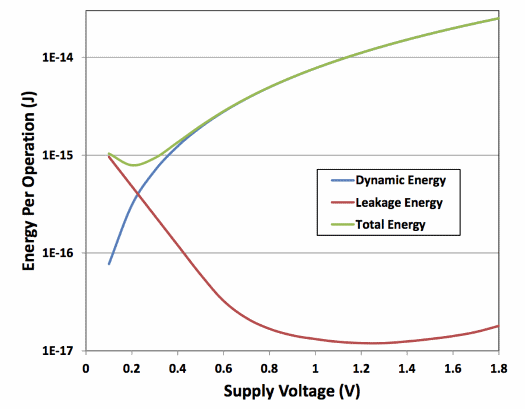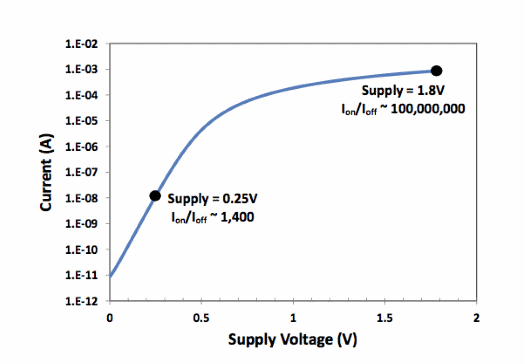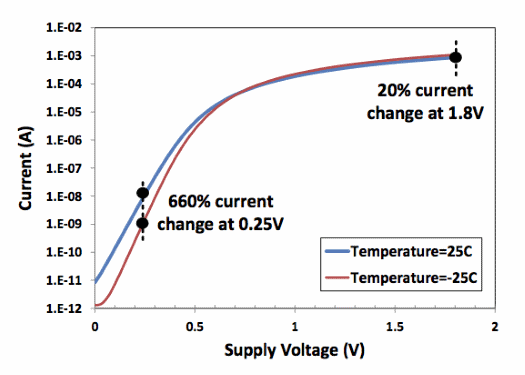BY MIKE SALAS, Vice President of Marketing,
Ambiq Micro,
www.ambiqmicro.com
The Internet of Things and the advent of ubiquitous computing have highlighted the importance of reducing power consumption throughout electronics.
If the immediate future will truly see the networking of all electronics and hitherto unconnected devices then the real prize is not to maximize the performance of the technology – the performance is fast enough to maintain an IoT already– it is to reduce energy consumption enough that the electronic things can function meaningfully within this new internet.
Energy is consumed in two fundamental ways: as leakage, when a circuit’s state isn’t changing, and dynamically as internal nodes are charged up and down. For realistic circuits in operation, dynamic power dominates – especially for the higher power supply voltages used in most designs today (see Fig. 1 ).

Fig. 1: Dynamic current dominates with higher operating voltage
Dynamic energy is determined by operating voltage
Sub-threshold techniques are a way to create circuits that consume dramatically less energy than those built using standard design practices. Sub-threshold design is challenging, but, given the right experience and diligence, it can be done and with immense benefits.
The results are circuits that provide the same functions as more traditional ones but use a fraction of the energy. There is no compromise in performance, robustness, or reliability. These chips can operate alongside their traditional counterparts with no externally-visible difference – except for the amount of energy required to drive them. They can provide important energy savings to designers building energy-efficient systems.
Because of the fundamental nature of these innovations, sub-threshold design techniques can be applied to virtually any type of IC device.
Sub-threshold was proven decades ago
Sub-threshold design isn’t a new concept. As far back as the 1970s, Swiss watchmakers noticed the potential of operating select transistors in the sub-threshold region. The idea was picked up for pacemakers and RFID tags, but never saw much acceptance beyond that.
What’s changed since the 70s, when the first commercial sub-threshold devices were created, is the scale of implementation. Designs of the past used a few critical sub-threshold transistors – on the order of 10. At that level, each transistor can be optimized by hand.
Ambiq creates entire chips that primarily use sub-threshold transistors. This equates to millions of transistors and cannot be done by hand but relies on the standard design tools and flows used to create super-threshold chips. It is these that Ambiq has achieved in order to commercialize sub-threshold circuits.
Ambiq Micro’s approach moves beyond the incremental improvements that other semiconductor companies have taken and makes revolutionary advances through a unique approach to the problem: sub-threshold circuit design. These considerations drove the development and commercialization of Ambiq’s patented Sub-threshold Power Optimized Technology (SPOT) platform, which Ambiq uses to build reliable, robust circuits that consume dramatically less energy on a cost-effective, mainstream manufacturing process.
Electronics energy consumption
Because dynamic energy varies as the square of the operating voltage, that voltage becomes the biggest lever for reducing dynamic energy consumption (while also having a tangible, but less dramatic, impact on leakage). For example, when compared to a typical circuit operating at 1.8 V, a ‘near-threshold’ circuit operating at 0.5 V can achieve up to a 13X improvement in dynamic energy. An even more aggressive ‘sub-threshold’ circuit operating at 0.3 V can achieve up to a 36X improvement!
Traditional digital designs use the transistor state – on or off – as a critical concept for implementing logic. Analog designs likewise assume that a transistor is on to some controlled degree, using it for amplification. But sub-threshold operation means that none of the voltages in the chip rise above the threshold voltage (Vth), so the transistors never turn on. Even a logic high voltage keeps the transistors off. This means that completely new design approaches are required.
The challenges of modern sub-threshold
Adapting the standard super-threshold flows and infrastructure for sub-threshold design presents numerous challenges, starting with the transistors themselves:
1. Poor transistor models
The transistor model forms the basis of everything in an integrated circuit design. All of the simulations, all of the abstractions and automation, the very process of design closure: they all rely on an accurate transistor model. Most transistor modeling has focused on the on characteristics of the device, with little attention given to off. The entire region between 0 V and Vth typically does not get modeled as accurately, and so existing models are inadequate for sub-threshold design, as shown in Fig. 2.

Fig. 2: Transistors haven't been well modeled below threshold
2. Logic swings and noise
The output response of a transistor in the sub-threshold regime is subtle; detecting it requires great sensitivity. Currents change exponentially in response to changing voltages, but they’re exceedingly small currents. In addition, the ratio of on to off current is on the order of 1,000, orders of magnitude less than what super-threshold designs experience (see Fig. 3). As can be expected, external noise can much more easily interfere with clean operation.

Fig. 3: The on/off current ratio is orders of magnitude smaller in the sub-threshold regime
3. Sensitivity to operating conditions
Sub-threshold designs are also far more susceptible to process and environmental variation than are super-threshold designs. For example, the current in a slow process corner can be 10 to 100 times less than that for a nominal process. Given that the on/off current ratio (above) is only on the order of a thousand, this cannot be ignored.
Variations in temperature provide a good example of how environmental conditions create a challenge for the designer. Vth depends on temperature, and Ion depends exponentially on Vth (as shown in Fig. 4). As a result, the off current at elevated temperature is similar in value to the on current at reduced temperature for an uncompensated circuit. Sub-threshold circuit design therefore requires extra effort to ensure that the circuits will operate as expected under all specified operating conditions.

Fig. 4: Sub-threshold circuits are exponentially sensitive to temperature
4. Logistical challenges
Much of the manufacturing flow is based upon assumptions that are reasonable for super-threshold designs but break down for sub-threshold designs. One obvious challenge can be found in the testers used to validate the silicon during production. The parametric measurement units (PMUs) that test voltages and currents are designed to measure microamps, not nano- or picoamps.
Even something as straightforward as device characterization has to be rethought simply because of the sensitivities that sub-threshold circuits have that super-threshold circuits don’t have. Typical characterization flows may not be thorough enough to prove that the circuits operate properly under all conceivable conditions.
The fundamental nature of these challenges, combined with the fact that few engineers are skilled in dealing with sub-threshold issues, explains the challenge of commercializing sub-threshold-based circuits.
Solutions
Ambiq’s SPOT technology addresses and overcomes all of these challenges. Moreover, sub-threshold design techniques can be applied to virtually any type of IC device. For example, Ambiq demonstrated the viability of this innovative approach with the introduction of the world’s lowest power real-time clock (RTC) in 2013. The upcoming release of the world’s lowest power 32-bit ARM-based microcontroller (MCU) further demonstrates the viability of extending these techniques to a completely different platform. Ambiq Micro is committed to expanding the SPOT Platform — and to giving batteries a better life.
Advertisement





